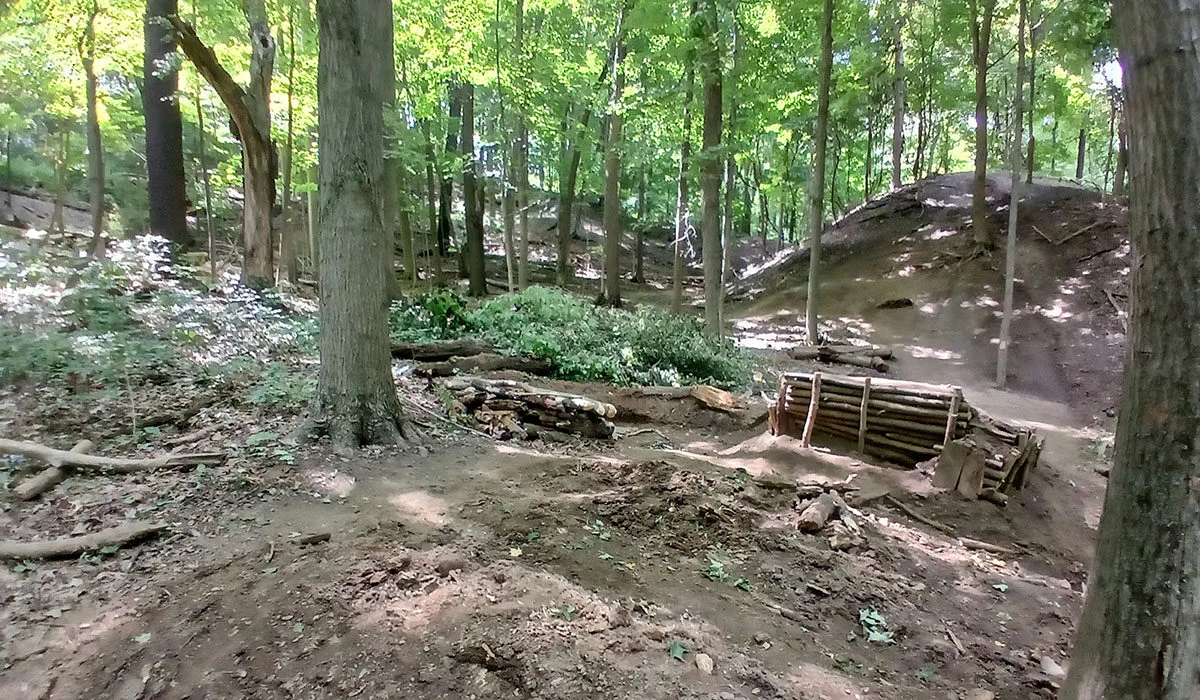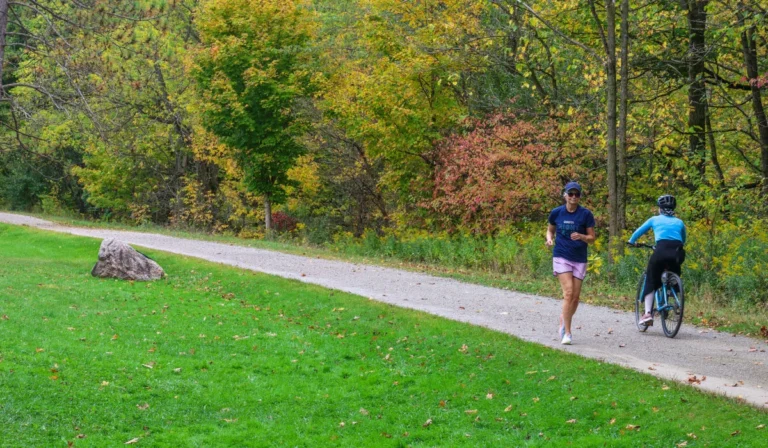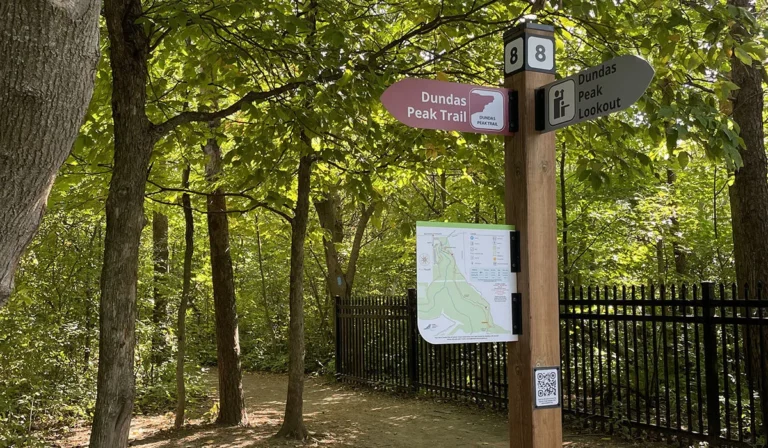Why Building Your Own Trails Hurts the Valley We All Love
We know how tempting it can be to head off the main trail, carve a shortcut, or shape a jump. It feels like a small action, something that adds a little more fun to your ride. The trouble is that those small actions add up. Every cut branch, moved log, or dug-up patch of soil leaves a mark that does not just disappear.
When people go off-trail or build structures in places like Dundas Valley, the impacts ripple out. Soil erosion makes streams cloudy and harms fish. Tires carry invasive seeds like garlic mustard and dog strangling vine, which quickly take over and crowd out native plants. Nesting birds are forced away when their habitat is disturbed, and salamanders hiding under rotting logs lose their shelter when wood is moved to build jumps or ramps.
Whenever we repair an unauthorized trail, we take time and resources away from maintaining safe trails, protecting sensitive habitats, restoring natural areas, and improving visitor experiences. What might feel like a small action has real consequences for the species, habitats, and landscapes we are here to protect.
Hamilton Conservation Authority (HCA) cares for thousands of hectares of natural areas and more than 180 kilometres of trails so they can be enjoyed today and protected for future generations. Our work includes protecting against flooding and erosion, managing conservation and recreational lands, and fostering environmental stewardship and education. Every unauthorized trail, jump, or structure undermines that mission, damaging habitats, accelerating erosion, and diverting staff time and resources away from projects that support the long-term health of these lands.
Authorized vs. Unauthorized Trails in the Valley
A quick way to tell what is official in Dundas Valley is by its width and markings. If a cart or pickup truck can fit down it, and you see trail markers and signs, it is an official trail that is safe, inspected, and regularly assessed for hazards like unstable trees. These are the trails where maintenance crews focus their efforts so you can ride, hike, or go horseback riding with peace of mind.
Small footpaths are unauthorized. They are uninspected for hazard trees and trail conditions, cut through sensitive ecosystems, and are areas where we do not want visitors, bikes, or horses to travel. Even if they look inviting, they are unsafe.
It is also important to know that cycling is not permitted on the Bruce Trail. If you see white or blue blazes marking the trail, that is your signal to walk, not ride. Please respect this rule to protect both the trail and the visitor experience.
Going off-trail or building jumps and shortcuts may seem harmless, but they damage the Valley and distract staff from other important work. This year alone, Dundas Valley staff have already spent over 90 hours and nearly $4,000 removing and rehabilitating unauthorized trails and jumps. Dismantling one course this summer took a day and a half, and in the off-season, with fewer staff, removals take even longer.
If you’re caught cutting trees or building unauthorized trails in a Conservation Area, you could face fines, orders to repair the damage, or even charges under the Conservation Authorities Act and local bylaws. Beyond the environmental harm, it could potentially be a costly mistake.
Trail Etiquette: How Bikes Should Use the Valley
Cyclists play a significant role in keeping the Valley safe and welcoming. A few simple habits go a long way:
- Stay on official trails. Do not take shortcuts or ride on rocks; remember that cycling is prohibited on the Bruce Trail.
- Yield responsibly. Uphill travellers, hikers, and horses have the right of way. Slow down, give notice, and be ready to stop.
- Pass with care. Call out before passing other riders or hikers, and when meeting horses, stop back, greet the rider, and only move forward once it is safe.
Even small choices matter. Riding off-trail or across moss-covered rocks leaves lasting damage to fragile habitats, and because moss grows slowly, those scars can remain for years.
Where to Ride Instead
If you want a place to ride that combines challenge with care for the environment, head to Christie Lake Conservation Area. HCA partners with the Hamilton Burlington Mountain Biking Association to build and maintain nearly 10 kilometres of sustainably designed single-track trails. With beginner, intermediate, and advanced options winding through pine forest and clay-based terrain, there is something for every rider. These trails are made for mountain biking. They are thoughtfully designed, regularly maintained, and offer the variety and flow riders want while protecting sensitive habitats. It is the perfect spot to test your skills and connect with the cycling community. Learn more about the trails and the partnership at: https://hbmba.ca/christie-lake/
Our Responsibility (and Yours)
We understand the Valley inspires a strong desire to explore. By staying on official trails, you help protect the landscapes that everyone comes here to enjoy. Hamilton Conservation Authority exists to preserve and protect our watershed’s health and connect people with nature in safe, sustainable, and lasting ways.
Please help us by:
- Staying on marked trails
- Avoiding the creation of jumps, cuts, or other unauthorized structures
- Respecting authorized trail infrastructure (if a truck can drive on it, it is legitimate)
- Yielding properly and riding thoughtfully as outlined above
- Choosing sanctioned areas like Christie Lake for your biking adventures
Together, we can ensure these conservation lands remain healthy, accessible, and resilient for future generations.
Contact
Gord Costie
Director, Conservation Areas Services
905-525-2181, ext. 168
Gord.Costie@conservationhamilton.ca
Brandon Good
Western Senior Manager, Conservation Area Services
905-525-2181, ext. 157
Brandon.Good@conservationhamilton.ca





